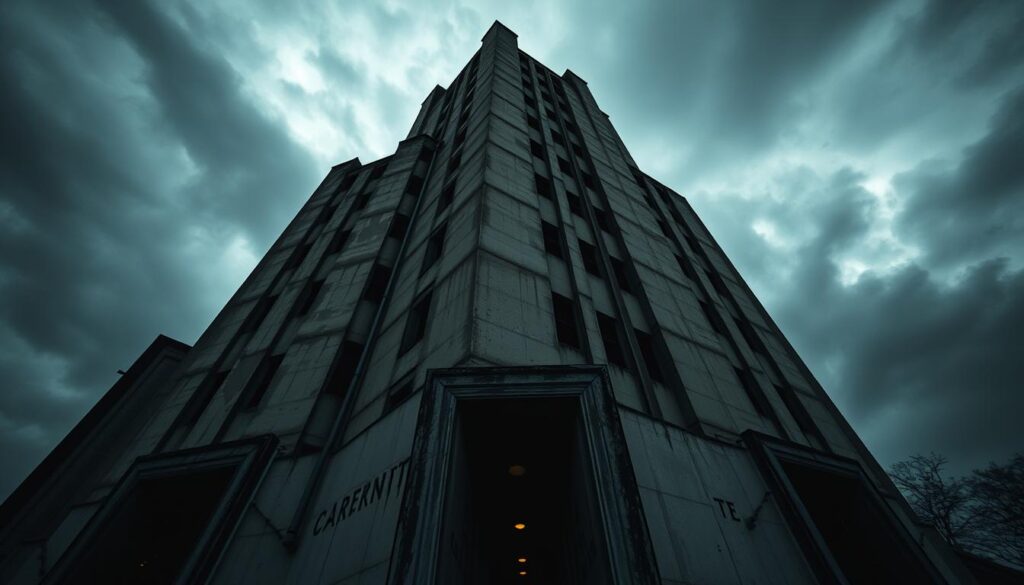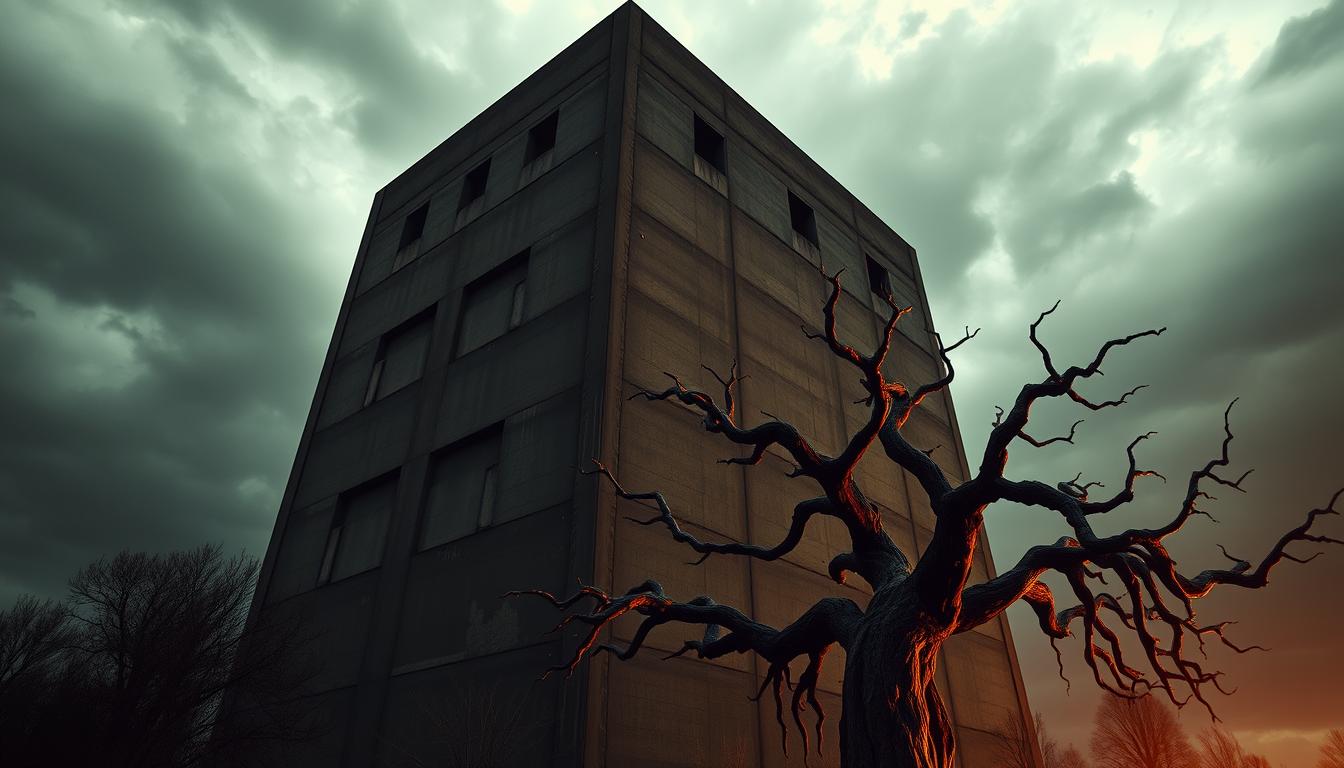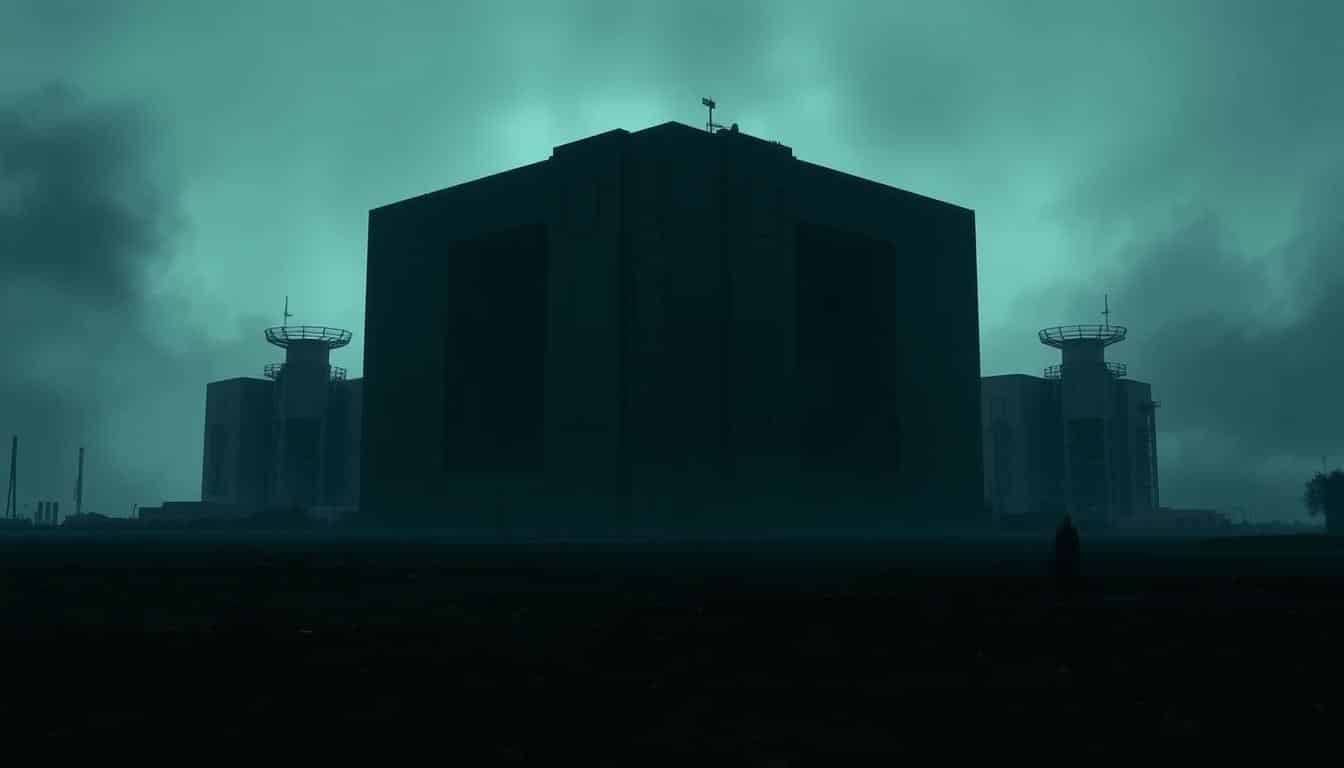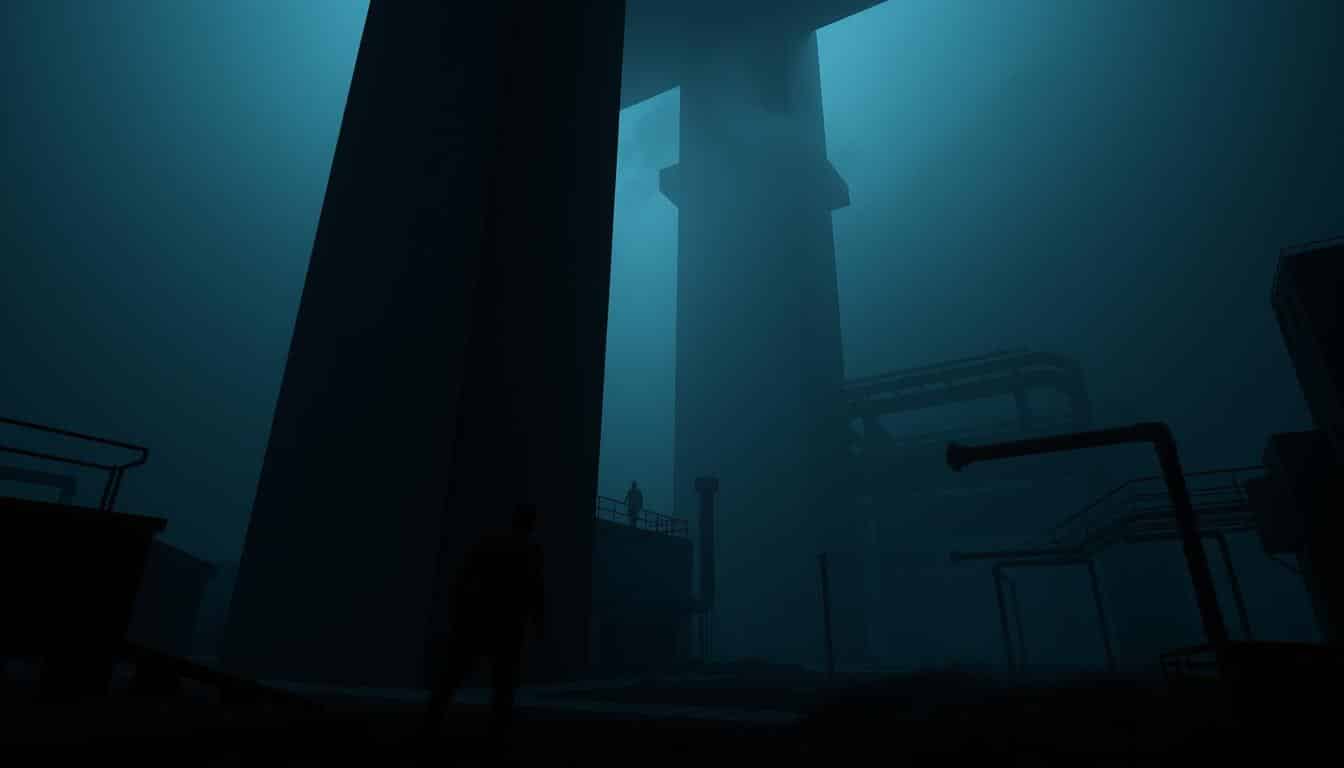Brutalism and horror storytelling show a deep mix of feelings tied to buildings. With its bare concrete looks, Brutalism brings out feelings of being alone. These feelings are strong in stories about fear.
This style is more than what you see; it becomes a big part of the horror. In High-Rise by J.G. Ballard, Brutalism shows the chaos when society falls apart. It makes us look into the scary parts of our minds.
By looking at this, we see how buildings change the way horror feels. Architecture adds deep feelings to horror stories.
The Allure of Brutalism in Horror
Brutalism attracts filmmakers and writers in the horror scene. Its plain shapes and bold lines catch their interest. These buildings make horror feel more real, adding to the scare with their eerie looks.
The idea of desolation and fear fits well with Brutalism’s style. It makes themes of loneliness and fear stand out. This style’s unique look brings out deep feelings in people today.
These buildings are more than just backdrops. They feel alive, adding to the horror story. The mix of real and supernatural scares feels right at home with Brutalism. This style’s bold yet plain look adds to the horror in a special way.

Brutalism in horror really makes us feel strong emotions. Writers and directors use its simple but striking designs to heighten the eerie atmosphere. This draws us into a spooky world, surrounded by concrete and darkness.
Understanding Brutalism’s Architectural Philosophy
Brutalism stands out in the world of architecture. It focuses on functionalism, honesty, and social purpose. Unlike traditional designs, it embraces a raw appeal.
Architects who follow this style care most about how spaces serve the community. This approach aims to create places that bring people together.
Artists and thinkers, like Mark Bittoni, see Brutalism as moving away from classic beauty. This movement celebrates the raw power of concrete and values structural honesty over decoration. Such buildings often stir strong feelings. People might feel drawn to or unsettled by these stark structures.
Brutalist principles affect not just architects but also the wider public. As people’s views change, interest in these buildings grows. Studying Brutalism helps us grasp how design influences our experiences.
How Brutalism Reflects Societal Chaos
Brutalism shows how society is in chaos. It uses stark designs to capture the rough spirit of today’s life. This style is all about raw concrete and simple shapes. It shows how people in cities feel disconnected from each other.
Buildings in this style show the broken parts of human life and the hard parts of living today. To understand society’s values, look at architecture. Brutalist buildings, like the Boston City Hall and the Barbican Centre in London, are more than just practical. They talk about how lonely people can feel in big cities. These heavy-looking buildings show how heavy urban life can feel, full of loneliness and doubt.
In scary stories, Brutalism brings out our fears about society’s mess. The scary look of these buildings is a perfect place for stories. Here, characters face their fears amid huge concrete buildings. Brutalism turns into a strong symbol of our fights in today’s world.
The Psychological Depth of Brutalism in Horror Storytelling
Brutalist architecture is a key element in horror stories, making viewers feel deep emotions. Its design of isolation and alienation adds layers to the story, making it more engaging. The concrete shapes act as barriers, both outside and inside the characters, creating a spooky mood.
Interpreting the Feelings of Isolation
In Brutalist buildings, the feeling of being alone is strong, making horror stories even scarier. This architecture style makes you feel trapped, like the characters in the stories. The heavy concrete makes people feel cut off from the world, making the theme of being alone even stronger. As characters move through these cold spaces, their sense of being all by themselves grows, pushing them into deeper psychological distress.
Concrete as a Reflection of Inner Turmoil
The strong design of Brutalism shows how deep psychological struggles can be in horror stories. The buildings and walls are more than just physical barriers; they show what the characters are going through inside. As they deal with their fears and wants, the tough concrete shows their emotional pain, reminding them of their sadness constantly. This link helps viewers face their own fears as they go through the story’s harsh truths.
Experiencing Alienation through Brutalist Structures
Interacting with Brutalist structures can make people feel deeply alienated. These large, concrete buildings can make one feel disconnected and uncomfortable. People in cities often talk about how these buildings make them feel alone. They say the cold concrete walls make them feel small and lost.
Many share stories of feeling very aware near Brutalist buildings. This awareness feels like something from a horror story. The huge, cold spaces of these buildings make people feel lonely and scared.
The way these buildings make people feel highlights how unique Brutalist architecture is. Their raw, bare look and lack of decoration stress the cold truth of city living. They seem to reflect the chaos and struggles people feel inside, much like in horror stories.
Brutalism and the Breakdown of Human Connection
Brutalism often symbolizes a world where people are disconnected. In stories with these severe buildings, characters show a big gap from each other and society. J.G. Ballard’s work paints this picture clearly. His characters deal with the cold Brutalist settings, showing us how we’re drifting apart.
Analyzing the Characters in J.G. Ballard’s ‘High-Rise’
In ‘High-Rise’ by Ballard, the people living in a Brutalist tower feel very alone. They mirror the coldness in society today. Living in the tower, they show us how far apart we’ve grown. Brutalism makes their loneliness even clearer.
The Archetypes Found in Brutalist Horror Tales
Brutalist horror stories use certain characters to show deep fear and loneliness. We see the distant watcher, the fixated bad guy, and the one who barely survives. They deal with their dark feelings against the backdrop of cold, hard Brutalism. Through their stories, we see how fragile our bonds with each other have become.
Cinema’s Depiction of Brutalism in Horror
Cinema uses Brutalism to boost the impact of horror stories. Stark, towering buildings make the viewer feel alone and scared. This creates a deep, lingering atmosphere in the movie. Directors use Brutalist architecture to speak visually about being isolated and hopeless.
Many horror movies use this style, making Brutalism stand out. These buildings add to the story by:
- Creating an eerie setting that raises the tension.
- Showing a clear difference from human experiences to emphasize emotional pain.
- Presenting a setting that mirrors society’s worries and fears, fitting horror movie themes.
Brutalist buildings bring viewers closer to feeling real fear. Their use in horror films triggers strong feelings, showing how buildings can shape stories. Films with Brutalism show us the shadows in human nature. They also connect deeply with the audience.
Analyzing Contemporary Horror Films with Brutalist Elements
Nowadays, horror movies are borrowing from Brutalist architecture to tell their stories better. The cold, harsh look of Brutalist buildings mirrors what characters feel inside. This setup highlights how alone and stressed they are. Directors use these buildings to make viewers uneasy. The buildings almost act like bad guys in the story.
“The Lighthouse” and “High-Rise” show how society and individuals can break down. The rough look of Brutalist buildings ramps up the tension among characters. This makes their surroundings affect their minds. Viewers get pulled into places that feel tight and harsh. This makes the story’s intense moments even stronger.
Bringing Brutalist designs into horror movies is a big change. It shows how important buildings are in telling the story. Filmmakers mix the real with the mental to challenge viewers. They invite us to face our fears in these big, scary buildings.
Conclusion
In summing up our journey through Brutalism’s role in horror, it’s clear this style is key to the genre’s depth. The earlier sections show Brutalism does more than catch the eye; it brings a deep, psychological layer to the stories we love. With its stark, towering designs, Brutalism stirs up feelings of loneliness and deep fear, key to horror’s appeal.
Moreover, Brutalism’s link to social turmoil highlights how it shows the collapse of human bonds. Through examples like ‘High-Rise’ by J.G. Ballard, we see how settings affect people’s minds. This boosts our fear and emotional reactions. So, this style is not just a setting but plays a big part in horror stories.
To wrap up, this draws us to think deeply about Brutalism’s role in horror, especially today. As we dive into how design and tales intertwine, Brutalism’s psychological layers will keep being crucial for both storytellers and fans.



